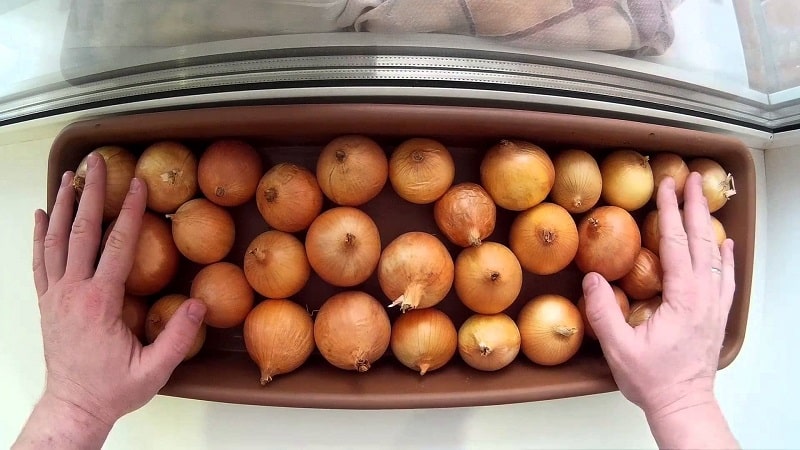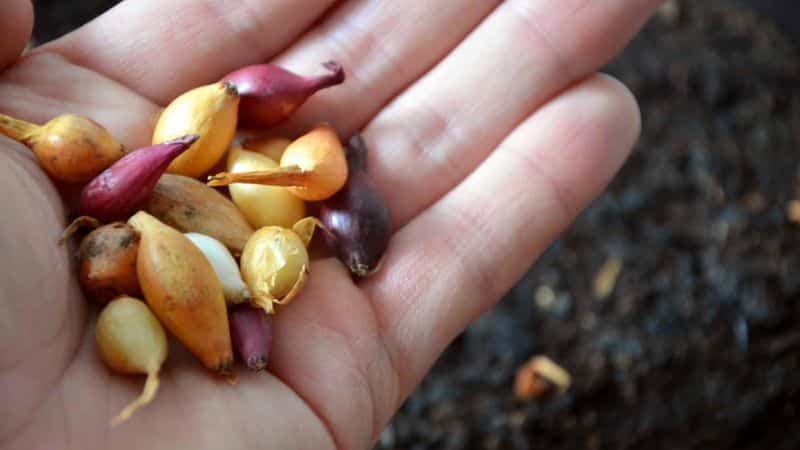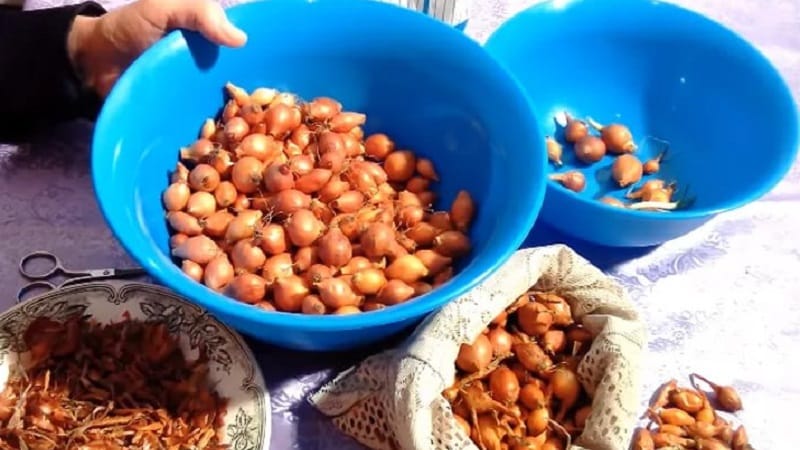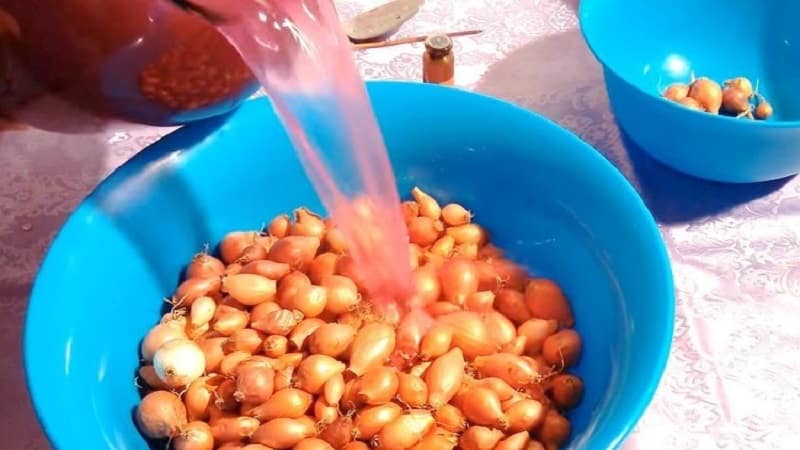Rules for processing onions before planting
Onions are grown in three ways - by sowing seeds, through seedlings and onion-sevcom. Pre-sowing treatment of planting material creates optimal conditions for the growth and development of the crop. We will tell you in the article how to properly prepare onions for planting and how to disinfect onion sets.
Why process onions before planting and what are the advantages of this?
More than 60% of harmful diseases caused by bacteria, viruses, and fungi are transmitted through seed material. For this reason, experienced farmers interested in a high-quality harvest disinfect onions before planting.
Onion seeds have a dense horn-like shell with low water permeability. To speed up the emergence of seedlings, before sowing, soak the seeds for a day in running water or change the water 2-3 times. When sowing prepared seeds in moist soil, seedlings appear in 7-8 days, dry ones germinate in 2-3 weeks.
Bulbs grown from seeds and sets treated with microelements have a high content of dry matter, including vitamins and sugars.

Optimal time for processing onions
Preparation of planting material in the southern regions begins at the end of February, in the northern regions - at the end of March.
Wet processing the nigella is subjected immediately before sowing - then there is no need to dry it, it is enough to bring it to a free-flowing state. Repeated soaking and drying reduces the germination of seed.
How and how to treat onions before planting
Seed material is disinfected before sowing or purchased already treated.
Processing agents:
- "Fitosporin-M". Before planting, the onions are immersed for 1 hour in a solution to disinfect them from pathogenic microorganisms. A solution is prepared from the powder form of the drug: 0.5 liters of water and 10 g of the product. The paste-like preparation is diluted in water in a ratio of 1:1, and then a working solution is prepared - 3 tbsp. l. concentrate per 200 ml of water. Working solution from liquid form: 10 ml of product and 200 ml of water.
- Potassium permanganate. The seeds are soaked in a 1% solution for 1 hour, the bulbs in a 0.1% solution for 2-4 hours.
- Soda solution. Dilute soda (1 tsp) in warm water (10 l) and soak the bulbs for 10-15 minutes.
- Saline solution. For prevention onion fly and protection from nematodes The seeds are soaked in clean water for 2 hours, then immersed in a saline solution (3 tablespoons per 5 liters of water) for 3-4 hours. They are washed and planted several times.
- Copper sulfate. Seeds are immersed for 1 hour in a 1% solution, bulbs - for 2-4 hours in a 0.25% solution.
- Ash. The ash is diluted in warm water (250 g per 5 l) and filled with a solution of sevka. Leave for 10 minutes, dry for 3 hours and plant in the ground.
- "Epin Extra". Stimulates root formation and increases productivity. For 1 kg of bulbs you will need 200 ml of working solution. Consumption of the drug is 0.25 g per 10 liters of water.
- Ammonium nitrate. Prevents diseases and protects against pests. 3 g of the drug are diluted in 10 liters of warm water and the seeds are soaked for 10-15 minutes.
- "Biolan", "Stimpo". Before planting, the bulbs are treated with a biostimulant, then kept in a solution of birch tar (1 tablespoon per 1 liter of water) for 3-4 hours.
- Kerosene. Used for watering the soil before planting. Dilute 1 tbsp in 5 liters of water. l. facilities.
If there is a deficiency of boron in the soil, soak the seed for 1 hour in a solution of boric acid 0.01%.

What other ways are there to prepare onions for planting?
After winter storage, the seedlings are sorted, sorted and prepared for planting. To grow turnips from sets of small-cavity varieties, heads with a diameter of 1-2.5 cm are used; for medium- and multi-cavity varieties, sets with a diameter of 1.5-3 cm give a high yield.
Sorting and drying
To ensure uniform germination, the seedlings are sorted out the day before the intended planting and damaged and dried out heads are discarded.
The nigella is poured with water and mixed - the full-fledged seeds settle to the bottom, the non-viable seeds float to the surface.
Germination test:
- Place cloth, cotton wool or soft paper on a saucer, moisten it and scatter seeds on top;
- covered with glass;
- onions germinate at a temperature of 25°C for 3-5 days.
The germination rate of onion seeds prepared for growing sets must be at least 80%, so they are pre-germinated.

Warming up
Warming up in hot water protects against peronosporosis, rot and mite damage. 1-2 days before planting, the bulbs are kept for 8 hours in water at a temperature of +40...+42 °C. Maintain a constant water temperature - lowering it will make the treatment ineffective, and raising it will damage the bulbs.
To protect against nematodes, use the following technique:
- the onion is soaked for a day in water at room temperature;
- then sharply increase the temperature to +45...+48°C - pour boiling water;
- take out the bulbs and dry them.
Onions are also disinfected if thrips have settled on the site.
Attention! 2-3 days before planting, the seedlings purchased in the store are heated at a temperature of +30...+40°C using heating devices.
Hardening
Before planting in the ground, onion seeds are wrapped in cloth and kept for 15 minutes in hot water at a temperature of +45...+50°C. Then immerse in cold water for 1 minute. This technique protects against fungal diseases.
Onion sets are kept at a temperature of 0...+10°C for 10 days 2-2.5 months before planting. The heads are then stored at room temperature.
Hardening stimulates plant immunity and reduces the likelihood of bolting.
Soak
Bulbs that are planted on greens in a greenhouse are pre-soaked for several hours in warm water.
Preparing seeds for growing into seedlings:
- water is poured into a liter jar at a temperature of +45…+50°C;
- add boric acid at the tip of a knife and mix;
- immerse the seeds and leave until completely cool;
- the seeds are laid out on a saucer on a cloth soaked in Energen solution;
- The saucer is covered with glass and left to germinate overnight.
In the morning, the seeds are planted in prepared nutrient soil.
The dry neck of each onion set is cut off. Fill a basin with hot water at a temperature of +40...+45°C and pour the seeds into the container - heating protects against bolting. Leave for 10-15 minutes, then transfer the planting material to a bowl of cold water for 2-3 minutes.
Then the onion is placed in a bucket, filled with a solution of complex organomineral fertilizer (“Biohumus” or “Gumi”), to which the natural growth stimulator “Energen” has been added according to the instructions. Leave overnight and remove from solution in the morning.
The nutrient solution improves immunity, speeds up the germination period, and promotes the production of strong ground shoots and large heads.

How to properly prepare the soil and cultivate beds
Onions require loose, well-drained soil.The crop has a long growing season - so that the onions can grow early and ripen before the onset of cold weather, choose a warm place.
For growing seeds, make beds 12-15 cm high and no more than 1 m wide. Humus or compost in the amount of 1-2 buckets per 1 m² is added for autumn digging.
In the spring, mineral fertilizers are applied during deep digging:
- ammonium nitrate – 15-20 g/m²;
- superphosphate – 25-30 g/m²;
- potassium chloride – 10-15 g/m².
A garden mixture containing a complex of mineral fertilizers is applied in an amount of 70-100 g/m².
Dig up, level the surface and water with a warm solution of copper sulfate (1 tablespoon per 10 liters of water) at the rate of 2 liters per 1 m². Cover with film and after 2-3 days sow the onions in furrows 2 cm deep.
The soil for sowing turnips is prepared in the same way as for seeds, while increasing the dose of mineral fertilizers by 2 times.
The soil is loosened, the surface is leveled, and transverse furrows are made. Sprinkle generously with a mixture of tobacco dust and sifted wood ash (1:1), and then spill with warm water. After this, the seedlings are planted and covered with nutritious loose soil. A mixture of tobacco dust and ash protects young plants from damage by onion flies.
Excessive deepening of the sets during planting, and of the seeds during sowing, leads to an extension of the growing season - a thick neck is formed on the bulb, which may result in thinning of the crops and a decrease in yield.
Important! The optimal planting depth for sets is 3-5 cm. For example, planting density in the Moscow region is 60-70 pcs/m². With a five-line scheme, 20-24 bulbs are planted per 1 linear meter of bed. Large fractions of sowing produce an early harvest.
Tips and tricks
The rejected seedlings are not thrown away, but are planted without preparation in a separate bed to obtain feathers.
Areas with neutral or slightly alkaline soils (pH 6-7) are allocated for onions. If horsetail or horse sorrel grow on the site, this indicates that the soil is acidified - which means it needs to be limed. Acidic soils are neutralized with wood or peat ash.
If there are perennial onions (onions, chives) on the site, crops and plantings of onions are planted as far as possible.
Fresh manure cannot be applied to the onions, otherwise the plants will delay growth and the period of leaf formation will increase. The bulbs form late, ripen poorly or not at all, are more susceptible to neck rot, and are poorly stored.
Conclusion
With a significant increase in the cost of onion sets, pre-sowing treatment of planting material is mandatory. It increases germination, reduces germination time, protects against diseases and pests.